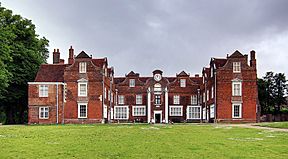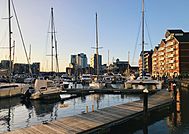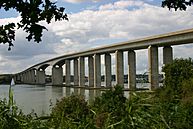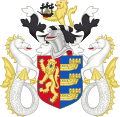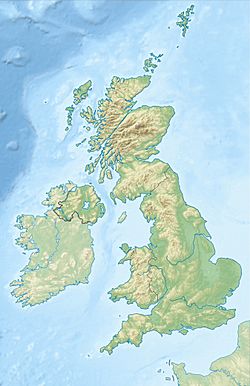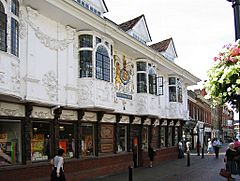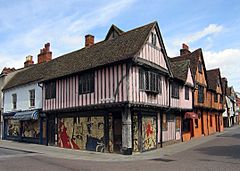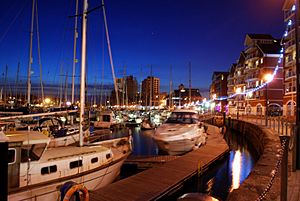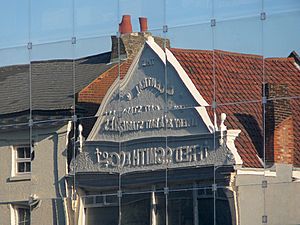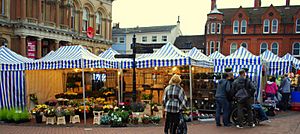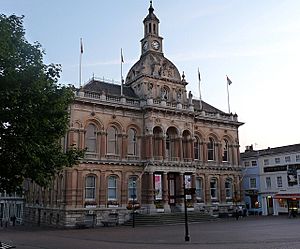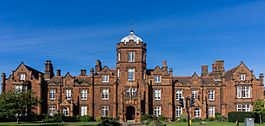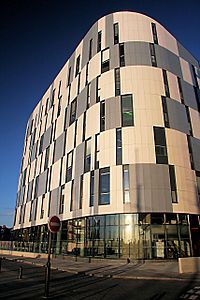Ipswich facts for kids
Quick facts for kids
Ipswich
Borough of Ipswich
|
||
|---|---|---|
|
Top to bottom, left to right: Christchurch Mansion, St Mary-le-Tower, Ipswich Waterfront, Orwell Bridge, Ipswich Town Centre
|
||
|
||
| Motto(s):
Munia civitatis decus civium
(The functions of citizenship are the glory of the citizens) |
||

Location within Suffolk
|
||
| Sovereign state | United Kingdom | |
| Country | England | |
| Region | East Anglia | |
| County | Suffolk | |
| Borough | Ipswich | |
| Government | ||
| • Type | Leader and Cabinet | |
| • Body | Ipswich Borough Council | |
| Area | ||
| • Total | 15.22 sq mi (39.42 km2) | |
| Population
(2019)
|
||
| • Total | Ranked 162nd 133,384 |
|
| • Ethnicity | 90.5% White 3.9% S. Asian 2.1% Black 1.1% Chinese or Other 2.4% Mixed Race |
|
| Postcode |
IP
|
|
| Area code(s) | 01473 | |
| Vehicle registration area code | AV, AW, AX, AY | |
| ONS code | 42UD | |
Ipswich is a large port town and borough in Suffolk, England, of which it is the county town. The town is located in East Anglia about 10 miles (16 km) away from the mouth of the River Orwell and the North Sea. Ipswich is both on the Great Eastern Main Line railway and the A12 road; it is 67 miles (108 km) north-east of London, 45 miles (72 km) east-southeast of Cambridge and 40 miles (64 km) south of Norwich. Ipswich is surrounded by two Areas of Outstanding Natural Beauty (AONB): Suffolk Coast and Heaths and Dedham Vale.
Ipswich's modern name is derived from the medieval name Gippeswic, probably taken either from an Anglo-Saxon personal name or from an earlier name given to the Orwell Estuary (although unrelated to the name of the River Gipping). It has also been known as Gyppewicus and Yppswyche. The town has been continuously occupied since the Saxon period, and is contested to be one of the oldest towns in the United Kingdom. Ipswich was a settlement of great economic importance to England throughout its history, particularly in trade. The town's historical dock, present-day Ipswich Waterfront, was known as the largest and most important dock in the kingdom.
Ipswich is a non-metropolitan district and is a large settlement despite its town status. The urban development of Ipswich overspills the borough boundaries significantly, with 75% of the town's population living within the borough at the time of the 2011 Census, when it was the fourth-largest urban area in the United Kingdom's East of England region, and the 42nd-largest urban area in England and Wales. In 2011, the town of Ipswich was found to have a population of 133,384, while the Ipswich Built-up area was estimated to have a population of 178,835 which extends from the town of Ipswich to Kesgrave, Woodbridge, Bramford and Martlesham Heath.
The town is divided into various quarters, with central and the waterfront drawing the most footfall. Central is home to the town's retail shopping and the historic town square, the Cornhill. The waterfront is located south of the town centre on the bend of the River Orwell and is a picturesque setting housing the town's impressive marina. The waterfront was historically an industrial port but has since been transformed into a trendy area lined with high-rise apartment buildings, restaurants, bars and cafés. The waterfront is also home to one of the UK's newest universities, the University of Suffolk, which was formed in 2016.
Ipswich has become a tourist hotspot in the UK with 3.5 million people reported to have visited the county town in 2016. In 2020, Ipswich was ranked as an emerging global tourist destination by TripAdvisor. Ipswich was voted as the 7th most desirable place to live and work in England by the Royal Mail in 2017. In 2007, Ipswich was awarded the cleanest town award and, in 2015, Ipswich was rated as the third happiest place to live in the UK.
Contents
History
Roman settlement
Ipswich is one of England's oldest towns, if not the oldest. The claim has also been made of the Essex town of Colchester, but that town was abandoned for some time, leaving Ipswich to claim to be the oldest continuously inhabited town in England. A large Roman fort, part of the coastal defences of Britain, stood at Walton near Felixstowe (13 miles, 21 km), and the largest Roman villa in Suffolk (possibly an administrative complex) stood at Castle Hill (north-west Ipswich).
Middle Ages
The modern town took shape in Anglo-Saxon times (7th–8th centuries) around Ipswich dock. As the coastal states of north-western Europe emerged from the collapse of the Roman Empire, essential North Sea trade and communication between eastern Britain and the continent (especially to Scandinavia, and through the Rhine) passed through the former Roman ports of London (serving the kingdoms of Mercia, the East Saxons, Kent) and York (Eoforwic) (serving the Kingdom of Northumbria).
Gipeswic (also Gippelwich)) arose as the equivalent to these, serving the Kingdom of East Anglia, its early imported wares dating to the time of King Rædwald, supreme ruler of the English (616–624). The famous ship-burial and treasure at Sutton Hoo nearby (9 miles, 14.5 km) is probably his grave. The Ipswich Museum houses replicas of the Roman Mildenhall and Sutton Hoo treasures. A gallery devoted to the town's origins includes Anglo-Saxon weapons, jewellery and other artefacts.
The 7th-century town was centred near the quay. Towards 700 AD, Frisian potters from the Netherlands area settled in Ipswich and set up the first large-scale potteries in England since Roman times. Their wares were traded far across England, and the industry was unique to Ipswich for 200 years. With growing prosperity, in about 720 AD a large new part of the town was laid out in the Buttermarket area. Ipswich was becoming a place of national and international importance. Parts of the ancient road plan still survive in its modern streets.
After the invasion of 869 Ipswich fell under Viking rule. The earth ramparts circling the town centre were probably raised by Vikings in Ipswich around 900 to prevent its recapture by the English. They were unsuccessful. The town operated a mint under royal licence from King Edgar in the 970s, which continued through the Norman Conquest until the time of King John, in about 1215. The abbreviation 'Gipes' appears on the coins.
King John granted the town its first charter in 1200, laying the medieval foundations of its modern civil government.
In the next four centuries it made the most of its wealth, trading Suffolk cloth with the Continent. Five large religious houses, including two Augustinian Priories (St Peter and St Paul, and Holy Trinity, both mid-12th century), and those of the Greyfriars (Franciscans, before 1298), Ipswich Whitefriars (Carmelites founded 1278–79) and Ipswich Blackfriars (Dominicans, before 1263), stood in medieval Ipswich. The last Carmelite Prior of Ipswich was the celebrated John Bale, author of the oldest English historical verse-drama (Kynge Johan, c.1538). There were also several hospitals, including the leper hospital of St Mary Magdalene, founded before 1199.
During the Middle Ages the Marian Shrine of Our Lady of Grace was a famous pilgrimage destination, and attracted many pilgrims including Henry VIII and Katherine of Aragon. At the Reformation the statue was taken away to London to be burned, though some claim that it survived and is preserved at Nettuno, Italy.
Around 1380, Geoffrey Chaucer satirised the merchants of Ipswich in the Canterbury Tales. Thomas Wolsey, the future cardinal, was born in Ipswich about 1475 as the son of a wealthy landowner. One of Henry VIII's closest political allies, he founded a college in the town in 1528, which was for its brief duration one of the homes of the Ipswich School. He remains one of the town's most famed figures.
Early-modern era
During the 14th to 17th centuries Ipswich was a kontor for the Hanseatic League, the port being used for imports and exports to the Baltic.
In the time of Queen Mary the Ipswich Martyrs were burnt at the stake on the Cornhill for their Protestant beliefs. A monument commemorating this event now stands in Christchurch Park. From 1611 to 1634 Ipswich was a major centre for emigration to New England. This was encouraged by the Town Lecturer, Samuel Ward. His brother Nathaniel Ward was first minister of Ipswich, Massachusetts, where a promontory was named 'Castle Hill' after the place of that name in north-west Ipswich, UK. Ipswich was also one of the main ports of embarkation for puritans leaving other East Anglian towns and villages for the Massachusetts Bay Colony during the 1630s and what has become known as the Great Migration.
The painter Thomas Gainsborough lived and worked in Ipswich. In 1835, Charles Dickens stayed in Ipswich and used it as a setting for scenes in his novel The Pickwick Papers. The hotel where he resided first opened in 1518; it was then known as The Tavern and later became known as the Great White Horse Hotel. Dickens made the hotel famous in chapter XXII of The Pickwick Papers, vividly describing the hotel's meandering corridors and stairs. The building now houses branches of Starbucks and Cotswold Outdoor.
In 1797 Lord and Lady Nelson moved to Ipswich, and in 1800 Lord Nelson was appointed High Steward of Ipswich.
19th and 20th centuries
In 1824 Dr George Birkbeck, with support from several local businessmen, founded one of the first Mechanics' Institutes which survives to this day as the independent Ipswich Institute reading room and library. The building, at 15 Tavern Street, has been the site of the library since 1836.
In the mid-19th century coprolite (fossilised animal dung) was discovered; the material was mined and then dissolved in acid, the resulting mixture forming the basis of Fisons fertiliser business.
The Tolly Cobbold brewery, built in the 18th century and rebuilt in 1894–1896, is one of the finest Victorian breweries in the UK. There was a Cobbold brewery in the town from 1746 until 2002 when Ridley's Breweries took Tolly Cobbold over. Felix Thornley Cobbold presented Christchurch Mansion to the town in 1896. Smaller breweries include St Jude's Brewery, situated in an 18th-century coach-house near the town centre.
Ipswich was subject to bombing by German Zeppelins during World War I but the greatest damage by far occurred during the German bombing raids of World War II. The area in and around the docks were especially devastated. Eighty civilians died by enemy action in the Ipswich county borough area during the latter war. The last bombs to fall on Ipswich landed on Seymour Road at 2 a.m. on 2 March 1945, killing 9 people and destroying 6 houses.
The Willis Building is a glass-clad building owned by Willis. Designed by Norman Foster, the building dates from 1974, when it was known as the Willis-Corroon building. It became the youngest grade I listed building in Britain in 1991, being at the time one of only two listed buildings to be less than 30 years old.
In September 1993 Ipswich and Arras, Nord Pas-de-Calais, France, became twin towns, and a square in the new Buttermarket development was named Arras Square to mark the relationship.
21st century
Ipswich has undergone an extensive rebuilding and a gentrification programme, principally around the waterfront. Though this has turned a former industrial dock area into an emerging residential and commercial centre, its completion was at the expense of much of the town's industrial and maritime heritage and in spite of efforts made by a local civic group, The Ipswich Society. Much of this development is residential, marketed to affluent DINKs. As such, some have considered it incompatible with Ipswich's existing socio-economic mix.
On 13 March 2007 Ipswich was awarded the cleanest town award.
Ipswich remains a 'town' despite a few attempts at winning 'city' status. It does not have a cathedral, so the Bishop of St Edmundsbury and Ipswich is based at Bury St Edmunds, the former county town of West Suffolk.
Districts
The Ipswich docks area ("the waterfront") is now devoted primarily to leisure use and includes extensive recent development of residential apartment blocks and a university campus. Businesses operated from the dock include luxury boats and a timber merchant. Other industries have been established to the south of the wet dock.
The Ipswich Village Development, begun in 2002 around Russell Road, is home to Suffolk County Council and Ipswich Borough Council.
Holywells is the area around Holywells Park, a 67-acre (27 ha) public park situated near the docks, and the subject of a painting by Thomas Gainsborough. Alexandra Park is the nearest park to the waterfont's northern quay, and situated on Back Hamlet, adjacent to University of Suffolk.
Chantry is a housing estate and park to the town's south-west.
Districts outside the town centre include Bixley Farm, Broke Hall, California, Castle Hill, The Dales, Gainsborough, Greenwich, Kesgrave (which is actually a separate town situated in Suffolk Coastal District), Maidenhall, Pinewood, Priory Heath, Racecourse, Ravenswood (built on a former airfield), Rose Hill, Rushmere, Springvale, St Margarets, Stoke, Warren Heath, Westbourne, Whitehouse and Whitton.
To the east of the town is Trinity Park near Bucklesham the home of the annual Suffolk Show, a typical county show. The 'Trinity' is the name given to the three animals native to the county of Suffolk, namely Red Poll cattle, the powerful Suffolk Punch horse and the black faced Suffolk sheep.
Culture
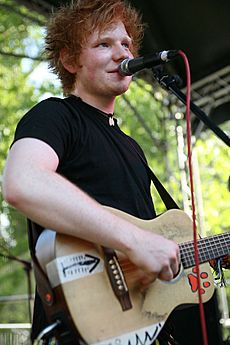
Ipswich is home to many artists and has a number of galleries, the most prominent of which are at Christchurch Mansion, the Town Hall, in Ancient House and the Artists' Gallery in Electric House. The visual arts are further supported with many sculptures at easily accessible sites. The Borough Council promotes the creation of new public works of art and has been known to make this a condition of planning permission. The town has three museums - Ipswich Museum, the Ipswich Transport Museum, and Christchurch Mansion.
The New Wolsey Theatre is a 400-seat theatre situated on Civic Drive. Although the Wolsey Theatre was built in 1979, The New Wolsey Company took on the management and running of the Wolsey Theatre in 2000, opening its first production in February 2001.
DanceEast, which has the primary aim of advocating innovation and development of dance in the East of England is now resident in their new premises as part of the waterfront development . They are building new premises as part of the waterfront development. These are the first custom built dance facilities in the East of England at a cost of around £8 million.
The Eastern Angles theatre group is based at the Sir John Mills Theatre in Ipswich, named after the famous actor who lived in Felixstowe as a child. In 2012 it celebrates its 30th anniversary. The group engages in rural tours and seasonal performances.
The Ipswich Arts Festival, known as 'Ip-art' has been the town's annual summer arts festival since 2003 and seen a developing and varied programme of events from visual arts, performing arts, literature, film and music, notably a free music day in Christchurch Park.
The Ipswich Jazz Festival is a jazz music and arts festival started in 2015 in partnership with the Ipswich Arts Festival and mixes established jazz talent, rising stars and regional players. It also features art and photography exhibitions, film screenings and workshops held in venues across the town.
Key Arts is an artist-run space using the redundant St Mary at the Quay Church on the waterfront. They hold a comprehensive programme of events and residencies during the year and have been running since 2006.
Norwich remains the regional centre for TV broadcasting, but both BBC East and Anglia TV have presenters and offices in Ipswich. The town has five local radio stations, BBC Radio Suffolk covering the entire county, where the East Anglian Accent can be heard on its many phone-ins, the commercial station Heart East Anglia which was founded in 1975 as Radio Orwell covering the A14 corridor in Suffolk, and Town 102 which was founded in 2006 and is the first full-time commercial station specific for Ipswich. The younger audience is catered for with Suffolk-based Kiss 105-108. Ipswich Community Radio was launched in 2007.
The town's daily newspaper is the Ipswich Star a sister title to the county's daily newspaper the East Anglian Daily Times.
Buildings


In addition to the Christchurch Mansion and Ancient House, Ipswich in the 21st century has some important cultural buildings including the New Wolsey Theatre and the Regent Theatre – the largest theatre venue in East Anglia where, in the 1960s, the Beatles performed when it was still known as the Gaumont.
There are several medieval Ipswich churches but the grandest is St Mary le Tower, rebuilt by the Victorians. Holy Trinity Church by Ipswich Waterfront is one of the few churches in the country which was built during the reign of William IV and whilst the outside looks plain, the interior is quite spectacular. The world's oldest circle of church bells is housed in St Lawrence Church.
The former East Suffolk County Hall is in the centre of Ipswich. It is listed as a building at risk by the Victorian Society. The Town Hall remains in use as an arts centre and events venue; it dates from 1866 (architects: Bellamy & Hardy of Lincoln).
Modern buildings include Endeavour House (headquarters of Suffolk County Council and formerly home of the TXU Corporation, Grafton House (home of Ipswich Borough Council) and Ipswich Crown Court, all located on Russell Road (Ipswich) in the area known as the Ipswich Village Development, which includes Portman Road stadium. The stadium has hosted England under-21, under-23, and international soccer matches, as well as rugby union and hockey matches.
In the Waterfront area The Mill is the tallest building in East Anglia, reaching 23 storeys.
On the north-west side of Ipswich lies Broomhill Pool, a Grade II listed Olympic-sized lido which opened in 1938 and closed in 2002, since which time a campaign to see it restored and re-opened has been run by the Broomhill Pool Trust. On the southern side of Ipswich is historic Belstead Lodge, now the Belstead Brook Hotel.
Transport

Railway
The town has two railway stations: Ipswich and Derby Road. It is situated on the Great Eastern main line from London to Norwich, the East Suffolk line to Lowestoft and the Felixstowe branch line. Trains in Ipswich are run by Greater Anglia, who operate direct services to cities in the region including London, Cambridge, Chelmsford, Norwich and Peterborough.
The town's railway engine shed opened in 1846 and closed in 1968. Ipswich is still a signing-on point for locomotive crews and a stabling point.
Buses
Bus services in Ipswich are operated by Ipswich Buses, First Norfolk & Suffolk, Beestons and several smaller companies. Town services mainly operate from Tower Ramparts bus station and regional services from the Ipswich Old Cattle Market bus station.
Roads
Ipswich is located close to the A12 and the A14 roads. The Orwell Bridge which carries the A14 road over the River Orwell is an important bridge for the region which connects the Port of Felixstowe to the rest of the country. The bridge is occasionally closed as a result of incidents or high winds; the closure of the bridge brings Ipswich to a standstill with diverted traffic.
Air
Ipswich Airport was closed in 1996, but the town is an hour away from Stansted Airport.
Other
It is 40 minutes away from Harwich international port and is also on Sustrans's National Cycle Route 1 and National Cycle Route 51. The port of Felixstowe is a major container port 12 miles (19 km) to the east.
Climate
Ipswich experiences an oceanic climate, like the rest of the British Isles, with a narrow range of temperature and rainfall spread evenly throughout the year. One of the two nearest for which data is available is East Bergholt, about 7 miles (11 km) south west of the town centre and at a similar elevation, and similar river valley/estuary situation. The average July maximum of 23.2c(73.7f) is the third highest for a major settlement in the country, behind London and Colchester, illustrating the relative warmth of the area during the summer part of the year.The record maximum is 35.2c(95.4f), set during August 2003. Typically 24.9 days of the year will record a maximum temperature of 25.1c (77.2f) or above, and the warmest day of the year should reach 30.0c(86.0f), on average.
The absolute minimum is -16.1c(3.0f), set in January 1963, although frosts have been recorded in all months except July, August and September. In an average year, 55.33 nights will report an air frost. The lowest temperature to be recorded in recent years was −14.5 °C (5.9 °F) during December 2010.
As with much of East Anglia, rainfall is low, averaging 569.3mm in a typical year, with 103.8 days of the year reporting over 1mm of rain. All averages refer to the period 1971–2000.
The weather station at Levington is even closer than East Bergholt at 9.4 kilometres (5.8 mi) from the town centre further down the river estuary on the way to Felixstowe. It has a slightly more marine climate than East Bergholt, with slightly lower highs and milder lows throughout the year in the 1981-2010 average period. It is slightly less prone to frosts, averaging 35.5 such occurrences in a calendar year. Sunshine levels at 1707.7 hours per annum are relatively high for the British Isles, but not abnormal for southern parts of England.
| Climate data for East Bergholt, elevation 7m, 1971–2000, extremes 1960- | |||||||||||||
|---|---|---|---|---|---|---|---|---|---|---|---|---|---|
| Month | Jan | Feb | Mar | Apr | May | Jun | Jul | Aug | Sep | Oct | Nov | Dec | Year |
| Record high °C (°F) | 15.9 (60.6) |
18.1 (64.6) |
23.1 (73.6) |
25.6 (78.1) |
28.9 (84.0) |
33.5 (92.3) |
35.0 (95.0) |
35.2 (95.4) |
31.5 (88.7) |
29.0 (84.2) |
20.6 (69.1) |
15.9 (60.6) |
35.2 (95.4) |
| Average high °C (°F) | 7.3 (45.1) |
7.5 (45.5) |
10.4 (50.7) |
13.5 (56.3) |
17.5 (63.5) |
21.2 (70.2) |
23.2 (73.8) |
23.0 (73.4) |
20.1 (68.2) |
14.9 (58.8) |
10.3 (50.5) |
7.9 (46.2) |
14.7 (58.5) |
| Average low °C (°F) | 0.9 (33.6) |
0.8 (33.4) |
2.3 (36.1) |
3.5 (38.3) |
6.2 (43.2) |
10.0 (50.0) |
12.3 (54.1) |
12.2 (54.0) |
9.8 (49.6) |
6.6 (43.9) |
3.1 (37.6) |
1.6 (34.9) |
5.8 (42.4) |
| Record low °C (°F) | −16.1 (3.0) |
−13.9 (7.0) |
−11.1 (12.0) |
−5.8 (21.6) |
−4 (25) |
−1.1 (30.0) |
2.3 (36.1) |
2.2 (36.0) |
0.0 (32.0) |
−5.5 (22.1) |
−8.4 (16.9) |
−14.5 (5.9) |
−16.1 (3.0) |
| Average precipitation mm (inches) | 52.14 (2.05) |
34.07 (1.34) |
41.63 (1.64) |
42.06 (1.66) |
41.80 (1.65) |
51.86 (2.04) |
35.50 (1.40) |
49.12 (1.93) |
51.31 (2.02) |
58.14 (2.29) |
56.25 (2.21) |
54.52 (2.15) |
569.31 (22.41) |
| Source: KNMI | |||||||||||||
| Climate data for Levington, elevation 22 m, 9.4 kilometres (5.8 mi) from Ipswich, 1981-2010 averages | |||||||||||||
|---|---|---|---|---|---|---|---|---|---|---|---|---|---|
| Month | Jan | Feb | Mar | Apr | May | Jun | Jul | Aug | Sep | Oct | Nov | Dec | Year |
| Average high °C (°F) | 7.2 (45.0) |
7.3 (45.1) |
10.1 (50.2) |
13.0 (55.4) |
16.4 (61.5) |
19.5 (67.1) |
22.3 (72.1) |
22.4 (72.3) |
19.1 (66.4) |
14.9 (58.8) |
10.5 (50.9) |
7.6 (45.7) |
14.2 (57.6) |
| Average low °C (°F) | 2.1 (35.8) |
1.8 (35.2) |
3.3 (37.9) |
4.6 (40.3) |
7.7 (45.9) |
10.5 (50.9) |
13.0 (55.4) |
12.9 (55.2) |
11.1 (52.0) |
8.3 (46.9) |
4.8 (40.6) |
2.5 (36.5) |
6.9 (44.4) |
| Average precipitation mm (inches) | 47.7 (1.88) |
38.7 (1.52) |
40.0 (1.57) |
38.9 (1.53) |
39.7 (1.56) |
49.1 (1.93) |
45.2 (1.78) |
46.5 (1.83) |
49.5 (1.95) |
61.7 (2.43) |
52.7 (2.07) |
50.9 (2.00) |
560.5 (22.07) |
| Mean monthly sunshine hours | 66.6 | 85.3 | 117.4 | 176.1 | 217.2 | 208.4 | 224.0 | 206.6 | 153.0 | 121.0 | 75.1 | 57.0 | 1,707.7 |
| Source: Met Office | |||||||||||||
Twin towns
Ipswich is twinned with Arras, France
Sport
Ipswich's sole professional association football club is Ipswich Town, which was established in 1878 and, as of 2021[update], plays in the third-tier EFL League One at the 30,300-capacity Portman Road stadium. Elected to the Football League in 1938, they have a strong rivalry with Norwich City, and were the previous club of the two most successful England managers, Alf Ramsey, who was buried in the Old Cemetery in the town on his death in 1999, and Bobby Robson. Ipswich won the League Championship in 1961–62 in their first season as a top division club during Ramsey's reign, as well as the 1978 FA Cup and the 1981 UEFA Cup under Robson. The club are also undefeated at home in all European competitions having drawn six and won the other 25.
Ipswich is also home to several non-League football clubs, including Ipswich Wanderers and Whitton United in the Eastern Counties League, and Achilles, Crane Sports, and Ransomes Sports among others in the Suffolk & Ipswich League. The town has representation in both codes of rugby. There are two rugby union teams – Ipswich RFC, who play in London 2 North East League, and Ipswich YM RUFC – and one rugby league side – Ipswich Rhinos, who play in the Rugby League Conference. Ipswich Cardinals are an American football team, playing in the South-East Conference of BAFACL 1; the second tier of the BAFA Community Leagues.
The speedway team, the Ipswich Witches, have ridden at Foxhall Stadium on the outskirts of Ipswich since 1951 and have won the top-tier league title four times, the knock-out cup five times and the second-tier knock-out cup twice. The stadium is also used regularly for Hot Rod, Stock Car and Banger racing events, hosting major events throughout the year on the stadium's outer tarmac oval.
Ipswich Gymnastics Centre is one of only three fully Olympic accredited gymnastics facilities in the UK. Ipswich Swimming, formed in 1884 as Ipswich Swimming Club, is based at the town's Crown Pools, and also uses the Fore Street swimming pool. The most successful club member is World Championship gold medallist Karen Pickering.
Ipswich had a racecourse which ran a mix of flat and National Hunt races.
Education
Schools
State-funded secondary schools include comprehensive schools such as Copleston High School, St Alban's Catholic High School, Holbrook Academy, Holbrook Primary and Northgate High School and academies such as Ipswich Academy and Chantry Academy. Ipswich is also home to several independent schools, including Royal Hospital School, Ipswich School (both are co-educational and members of the Headmasters' and Headmistresses' Conference), Ipswich High School (has recently changed from girls only to girls and boys) and St Joseph's College (Catholic, co-educational) which hosts an international summer camp.
Further and higher education
Suffolk New College is a further education college located in Ipswich, serving students from the town and wider area. There is also a sixth form college, One, which serves students from the same area.
Ipswich is the location of the University of Suffolk, Suffolk's first Higher Education Institution (HEI), established in 2007. It was originally University Campus Suffolk, a collaborative venture involving the University of Essex in Colchester, the University of East Anglia in Norwich, various further education colleges and Suffolk County Council. However, the university was granted its own degree awarding powers in November 2015, and in May 2016 it was awarded university status. The university was renamed to the University of Suffolk in August 2016, prior to its former name University Campus Suffolk.
Notable residents
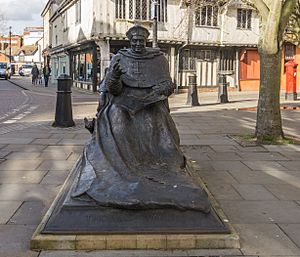
The Tudor Cardinal Thomas Wolsey was born in the town. Sir Samuel Mayart, the judge and political theorist, was born in Ipswich in 1585. The artist Thomas Gainsborough and the cartoonist "Giles" worked here, Horatio, Lord Nelson, became Steward of Ipswich, and Margaret Catchpole began her adventurous career here. Alf Ramsey and Bobby Robson were both successful managers of Ipswich Town. Ipswich was the birthplace in 1741 of Sarah Trimmer, née Kirby, writer and critic of children's literature and among the first to introduce pictorial material and animals and the natural world into it. Also born in Ipswich is Sam Claflin, who appeared in The Hunger Games and Peaky Blinders.
Actor and director Richard Ayoade, best known for his role as Maurice Moss in The IT Crowd, was brought up in Ipswich, as was the ceramic artist Blanche Georgiana Vulliamy, and the musician Nandi Bushell. Hugh Catchpole (OBE, CBE, Hilal-i-Imtiaz), a noted educationist with over 60 years of association with military schools and colleges in India and Pakistan, was born in Ipswich.
Images for kids
-
The Ipswich Museum
-
Ipswich Town Hall on The Cornhill town square
-
The Willis Building in Ipswich was one of Foster + Partners earliest commissions built in 1975
See also
 In Spanish: Ipswich para niños
In Spanish: Ipswich para niños


